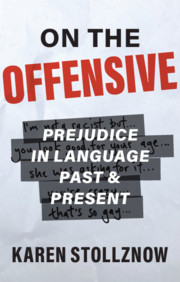
-
Select format
-
- Publisher:
- Cambridge University Press
- Publication date:
- 06 October 2020
- 15 October 2020
- ISBN:
- 9781108866637
- 9781108791786
- Dimensions:
- Weight & Pages:
- Dimensions:
- (216 x 140 mm)
- Weight & Pages:
- 0.42kg, 322 Pages
You may already have access via personal or institutional login
Book description
I'm not a racist, but… You look good, for your age… She was asking for it… You're crazy… That's so gay… Have you ever wondered why certain language has the power to offend? It is often difficult to recognize the veiled racism, sexism, ageism (and other –isms) that hide in our everyday discourse. This book sheds light on the derogatory phrases, insults, slurs, stereotypes, tropes and more that make up linguistic discrimination. Each chapter addresses a different area of prejudice: race and ethnicity; gender identity; sexuality; religion; health and disability; physical appearance; and age. Drawing on hot button topics and real-life case studies, and delving into the history of offensive terms, a vivid picture of modern discrimination in language emerges. By identifying offensive language, both overt and hidden, past and present, we uncover vast amounts about our own attitudes, beliefs and values and reveal exactly how and why words can offend.
Awards
Winner, 2022 Choice Outstanding Academic Titles
Reviews
‘I don't think there is any more difficult topic in present-day language study than the vocabulary of offence. Karen Stollznow has done us all a great service in bringing together the largest collection of usages I have ever seen, in all the main areas of linguistic prejudice, and treating them in an enlightened, informative, and sensitive manner. It will help anyone who has ever offended others or been offended by a use of language – which means all of us.'
David Crystal - University of Wales, Bangor
‘The strength of the book is its comprehensiveness: it covers terms from history, current affairs, literature, public policy, advertising, and popular culture, and includes brief etymological notes... will be of immense value to scholars studying offensive language, both as a baseline for research and a source of ideas to be explored further … Highly Recommended.'
E. L. Battistella Source: Choice
‘… an accessible read for a broad audience in a wide range of settings. The book is intended for use in professional settings such as workplaces and schools as well as in social settings like within families and communities.’
Dominique Branson Source: Language in Society
Contents
Metrics
Altmetric attention score
Full text views
Full text views help Loading metrics...
Loading metrics...
* Views captured on Cambridge Core between #date#. This data will be updated every 24 hours.
Usage data cannot currently be displayed.
Accessibility standard: Unknown
Why this information is here
This section outlines the accessibility features of this content - including support for screen readers, full keyboard navigation and high-contrast display options. This may not be relevant for you.
Accessibility Information
Accessibility compliance for the PDF of this book is currently unknown and may be updated in the future.


